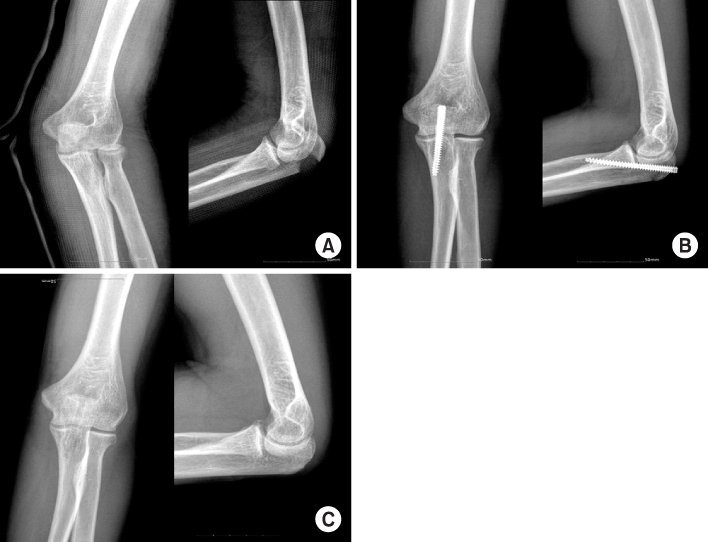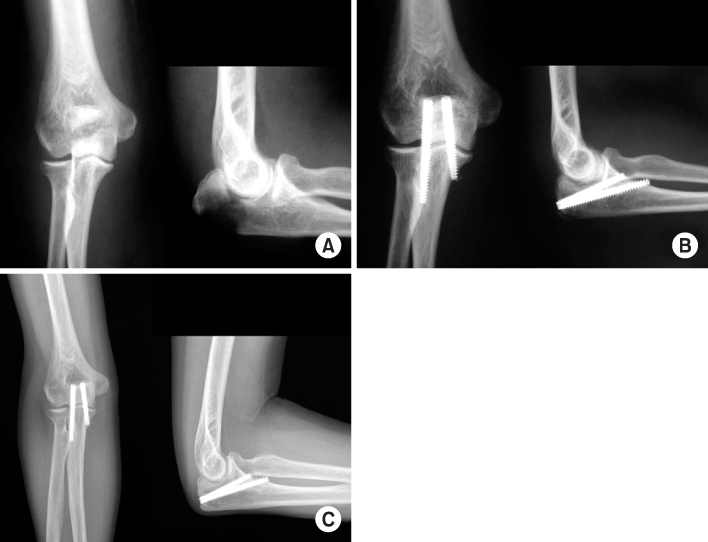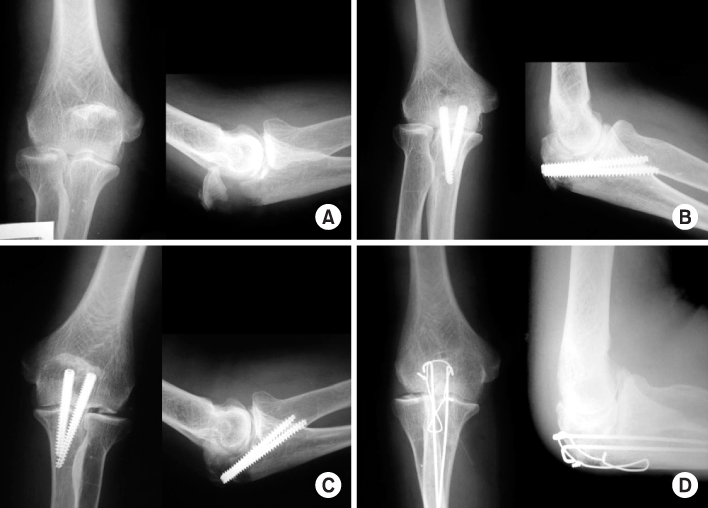J Korean Fract Soc.
2009 Oct;22(4):270-275. 10.12671/jkfs.2009.22.4.270.
Treatment of Ulnar Olecranon Fracture Using Acutrak Screw
- Affiliations
-
- 1Department of Orthopedic Surgery, Wallace Memorial Baptist Hospital, Busan, Korea. medifor@paran.com
- KMID: 1469994
- DOI: http://doi.org/10.12671/jkfs.2009.22.4.270
Abstract
- PURPOSE
To evaluate the clinical results of Acutrak screw fixation for ulnar olecranon fractures. MATERIALS AND METHODS: We reviewed 15 cases of ulnar olecranon fractures which were treated with Acutrak screws from February 2003 to September 2007. Follow-up period is from 12 months to 42 months. We used Mayo classification. Radiologic results were analyzed according to step-off, gap, reduction loss, and functional results were analyzed according to pain and ROM. We analyzed union time, operation time, incision size and complications. RESULTS: In functional results, there were 3 good cases out of 3 Mayo type IA, 8 good cases and 2 fair cases out of 10 type IIA, 1 fair case and 1 poor case out of 2 type IIB. In radiologic results, there was 1 case of reduction loss. Average union time was 9.4 weeks, average operation time was 24 minutes and average incision size was 1.8 cm. CONCLUSION: We conclude that Acutrak screw fixation can be a treatment option for olecranon fracture of Mayo type IA and IIA.
Keyword
MeSH Terms
Figure
Reference
-
1. Adla DN, Kitsis C, Miles AW. Compression forces generated by Mini bone screws--a comparative study done on bone model. Injury. 2005; 36:65–70.
Article2. Bryan RS. Fracture about the elbow in adults. Instr Course Lect. 1981; 30:200–223.3. Cabanela ME, Morrey BF. Fractures of the proximal ulna and olecranon. In : Morrey BF, editor. The elbow and its disorder. 2nd ed. Philadelphia: WB Saunders Co;1993. p. 407–408.4. Cho DY, Lee JM, Kim HC, Kim HJ. Clinical analysis of fractures around th elbow joint in adults. J Korean Soc Fract. 1995; 8:430–438.
Article5. Conn J, Wade PA. Injuries of the elbow: a ten year review. J Trauma. 1961; 1:248–268.6. Daland EM. Fractures of the olecranon. J Bone Joint Surg. 1933; 15:601–607.7. Eriksson E, Sahlin O, Sandahl U. Late results of conservative and surgical treatment of fracture of the olecranon. Acta Chir Scand. 1957; 113:153–166.8. Gartsman GM, Sculco TP, Otis JC. Operative treatment of olecranon fractures. Excision or open reduction with internal fixation. J Bone Joint Surg Am. 1981; 63:718–721.
Article9. Helm RH, Hornby R, Meller SW. The complications of surgical treatment of displaced fractures of the olecranon. Injury. 1987; 18:48–50.
Article10. Hume MC, Wiss DA. Olecranon fractures. A clinical and radiologic comparison of tension band wiring and plate fixation. Clin Orthop Relat Res. 1992; 285:229–235.11. Muller ME, Allgower M, Schneider R, Willenegger H. Mannual of internal fixation. 3nd ed. Berin: Springer Verlag Co;1991. p. 44–55. p. 460–461.12. Murphy DF, Greene WB, Dameron TB Jr. Displaced olecranon fractures in adults. Clinical evaluation. Clin Orthop Relat Res. 1987; 224:215–223.
Article13. Park SW, Hur CY, Shim JH. Operative treatment of olecranon fracture. J Korean Soc Fract. 1994; 7:58–64.
Article14. Watson-Jones R. Fractures and Joint Injuries. 6th ed. Churchill Livingstone Co;1982. p. 650–655.15. Wheeler DL, McLoughlin SW. Biomechanical assessment of compression screws. Clin Orthop Relat Res. 1998; 350:237–245.
Article
- Full Text Links
- Actions
-
Cited
- CITED
-
- Close
- Share
- Similar articles
-
- Tardy Ulnar Nerve Palsy after Olecranon Fracture: 3 Cases Report
- Surgical Treatment of Using Acutrak Screw for Ankle Medial Malleolar Fracture
- Stress Fracture of Olecranon after Plate Fixation for Osteoporotic Monteggia Fracture with Absence of Radial Head: A Case Report
- Treatment of a Segmental Ulnar Shaft Fracture and an Olecranon Fracture
- Treatment of Acute Scaphoid Fracture by Percutaneus Acutrak Screw Insertion




